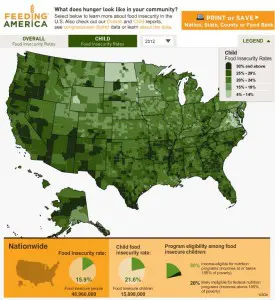 Even as unemployment numbers have improved, families across the country still struggle to put food on the table. A new Feeding America report on local-level food insecurity reveals that in every state in America, children are at a greater risk of experiencing hunger than the overall population.
Even as unemployment numbers have improved, families across the country still struggle to put food on the table. A new Feeding America report on local-level food insecurity reveals that in every state in America, children are at a greater risk of experiencing hunger than the overall population.
Map the Meal Gap, an annual report on state, county, and congressional district food insecurity rates, finds that food insecurity looks different in each community. In 2012 child food insecurity rates ranged by county, from a low of 4 percent in Bowman County, North Dakota, to a high of 41 percent in Zavala, Texas. Among the counties with the highest food insecurity rates, more than 1 in 3 children are estimated to be food insecure, meaning that at some point in the year they do not know where their next meal will come from.
Without proper nutrition, children cannot have the healthy start to life that they deserve. Food insecure children are more vulnerable to infections and illness, more likely to struggle in school, and have a higher risk of behavioral problems.
Federal assistance programs like the Supplemental Nutrition Assistance Program (SNAP), the Special Supplemental Nutrition Program for Women, Infants, and Children (WIC) and free and reduced-price lunch provide a critical source of nutrition assistance to food insecure children.Map the Meal Gap 2014 reveals that eligibility rules are such that in 94 percent of counties, a majority of the food insecure children are likely income-eligible for federal nutrition programs.
However, we also know that federal nutrition programs could do much more to address child food insecurity. Eligible children might not have access to programs in their communities and face hunger over the weekends, holidays, and summers when school is not in session. For example, other data shows that compared to the more than 21 million children receiving free or reduced-price lunches each school day in 2013, only 11.2 million received breakfast and even fewer, 2.4 million, received food assistance during the summer months.
There are also millions of children whose families struggle to put food on the table but do not qualify for federal nutrition assistance. These families must rely on local charities that provide afterschool or summer feeding programs, weekend BackPack programs, school pantries, or food pantries, that supply these hungry children with nutritious food.
It is important that policymakers protect and invest in federal child nutrition programs like SNAP, WIC, and school meals so that more children aren’t faced with hunger. In addition, schools and communities should look for ways, such as the recent community eligibility provision, to make sure that all eligible students get access to healthy school meals. And when families do not qualify for nutrition programs it is important to look for ways to support local food banks and hunger organizations so that all children have access to food. Some families in the “gap” may make too much money to qualify for federal programs, but face issues like the rising cost of childcare and stagnant wages which may prevent them from being able to meet their children’s full nutritional needs.
Both food insecurity and program eligibility rates vary from county to county. But by providing data about hunger at the state and county level, Map the Meal Gap 2014 can help policymakers, service providers, and advocates identify strategies to best reach the families and children in need of food assistance.